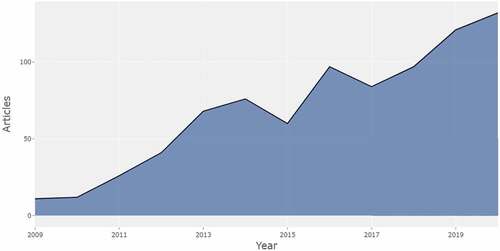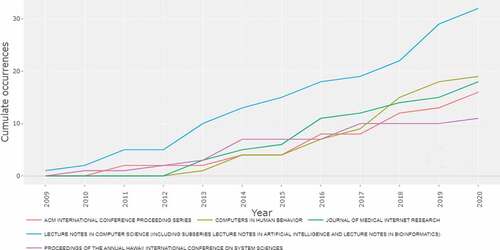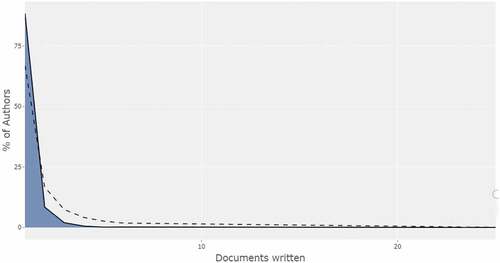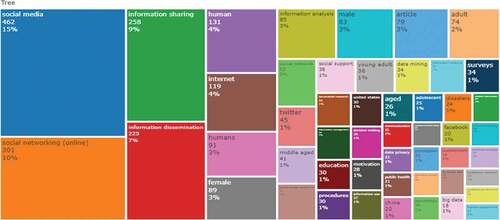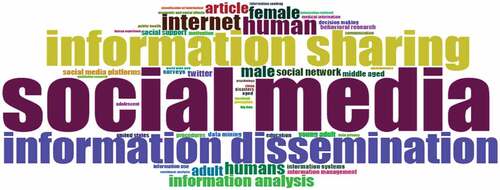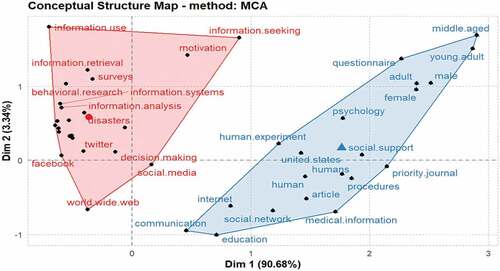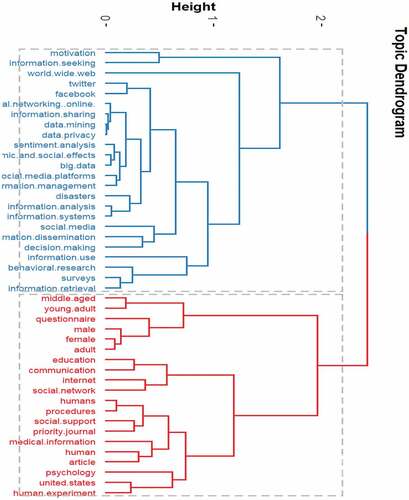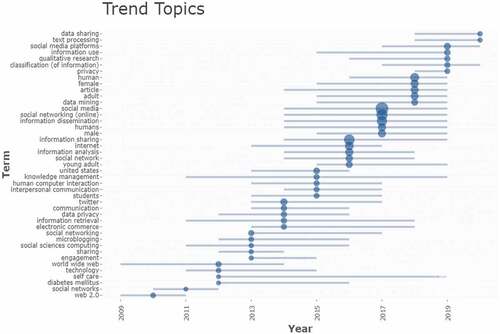Abstract
Social media has evolved at a rapid pace, influencing every aspect of the global community. The purpose of this paper is to use bibliometric analysis tools to evaluate valid works on the relationship between social media and information sharing. A review study of research papers on social media and information sharing published between 2009 and 2020 was conducted. The bibliometric analysis identified the following characteristics: (1) the primary articles are based on information sharing through social media; (2) the main authors deal with information sharing in social media; (3) the newestrend topics related to information sharing in social media are demographic characteristics, cognition, sentiment, healthcare, products and services recommendations, tourist recommendations, and COVID-19. The results show significant impact rates in studies of information sharing in social media. Overall, this study serves as a basis for new scientific questions that will contribute to the further development of this research field.
PUBLIC INTEREST STATEMENT
The rising interest in exploring the role of social media in sharing information in different aspects like social media platforms (Facebook, Twitter, and Instagram), and different aspects like organizations, consumers behavior, health information, COVID-19, and user-generated content, which is a massive machine-human knowledge processing function capable of managing volumes of information sharing. This study provides the global trend in scientific publications in the area of “social media and information sharing” according to the outputs of publications such as type of document, annual scientific production, scientific sources, source growth, number of articles per author, the frequency distribution of scientific productivity, keywords of the author, thematic dendrogram, factorial map of the document with the highest contributions, citation of the articles, production of the country, citation of the country, and map of collaboration of the country.
2. Introduction
The term “social media,” coined in the late 1990s, has become so popular that it now has over 2 billion active users worldwide (Osatuyi, Citation2013). Social media, by definition, are computer-mediated technologies that allow people to share information, ideas, and other expressions through virtual communities and networks (Obar & Wilman, Citation2015). Social media has transformed communication between businesses and customers by connecting everyone in ways previously unimaginable (Kietzmann et al.,Citation2011) .
Given its increasing popularity and informative use, the study of social media seems to offer great scientific potential, especially about information behavior. It is useful to approach social media from an information behavior perspective, as it is concerned with “how people need, seek, manage, give, and use information in different circumstances”. By sharing information or posting activities, social media encourage people to communicate more on the Internet. The amount of social information communicated (e.g., posts, comments, likes) between individuals on social networks can be used to define the relationship (Hendry et al., Citation2017). Social networks make more visible the ties and connections that have always bound people together, such as the relationships between teams, partnerships, tribal groups, alliances, businesses, institutions, organisations, and health care, to name a few; types of relationships that were less visible before the existence of social networks (Hansen et al., Citation2011; Kapoor et al., Citation2018). It is possible to use the information available in social networks to identify knowledge that can be valuable in providing better products and services to people in different industries. For example, in the area of recommender systems (RS), social networks can help researchers and developers better understand user preferences because the masses of information produced by online users on social networks create new opportunities to help researchers and developers better understand user preferences(Alejandra & Camacho, Citation2020).
Additionally, sharing information in social media during COVID −19 can consider one of the most important trends (Armitage et al., Citation2020; Islam et al., Citation2020; Laato et al., Citation2020; Picone et al., Citation2020; Shehata, Citation2021; Yusof et al., Citation2020). As (Islam et al., Citation2020) noted that People take crisis-related information seriously and share COVID −19 information on WhatsApp not only to be entertained and inquire about status or information, but also to help others. In addition, the study identified reciprocity rules, habitual distraction and socialisation as motivators for WhatsApp users’ positive attitude towards COVID −19 information sharing. (Nadia et al., Citation2020)Suggested that a discussion be held on how to ethically manage the Malaysian response to the pandemic COVID −19 in terms of information sharing. It is suggested that the general population develop basic skills to evaluate information and determine its validity. In addition, online health information has the potential to improve people’s quality of life. In studying the health information behaviour of Egyptian students during the pandemic COVID −19, (Shehata, Citation2021) found that the level of health information literacy and information skills affects a person’s ability to obtain trustworthy and valuable health information.
As a result, the authors wonderwhat academic efforts have been made to study social media and information behavior and characterize the state of the field. This study will focus on the current academic debate and attempt to identify significant research and researchers in the field as well as the overall pace of publications. In recent years, researchers and practitioners have explored and studied the numerous aspects of social media. Organizations use social media to get input from their stakeholders (Phang et al., Citation2015). Consumer reviews are another important aspect of social media that raises concerns about the quality, credibility, and authenticity of information. Microblogging has become extremely popular due to the success of online communities that bring together people with similar interests and aspirations. While the majority of messages shared on social media are personal status updates or messages, other posts are support-seeking, in which people ask for help and support(Alalwan et al., Citation2017; Dwivedi et al., Citation2017; Ismagilova et, Citation2017; Kapoor & Dwivedi, Citation2015; Kapoor et al., Citation2016, Citation2018; Plume et al., Citation2016). Moreover, sharing information during COVID −19 is another big part of social media nowadays, and need to identify significant research and researchers in that topic as well.
There is a comprehensive review that integrates and summarises the results of articles published in business information systems journals. Even though the authors discovered by reviewing the literature, there is a lack of understanding of the main trends and themes in this topic. Also, according to the author’s knowledge, there is not any previous study analyze the articles by using bibliometrics and specially biblioshiny by R package to understand deeply the information sharing in social media trends and their interest in different cultures and countries. The existence review studies have been done in different countries around the globe sharing information in different contexts. However, fewer studies investigate the previous studies in sharing information in social media by gathering organizations, consumer behavior, demographic, health, and COVID-19. So, the current research evaluates the overall influence and productivity of these studies to see if other scholars are paying attention to this work and to identify thematic areas of strength and weakness.
the main contributions of this paper discuss the findings of 825 publications contributing to the literature on social media and information sharing by using bibliometrics which is gradually extending to all disciplines. It is particularly suitable for science mapping at a time when the emphasis on empirical contributions is producing voluminous, fragmented, and controversial research streams. And this type of study has not been used before in this Multiple emergent themes in these quantitative variables and have been identified to enhance understanding of the advances in social media research in sharing information. By building on Bibliometrics findings of previous social media and information sharing research, The description of the main bibliometric statistics is followed by the analysis of the results many Several recent studies have managed to theorise the nature of most social media networks,like Twitter and Instagram, and different filed like organizations, consumers behavior, health information, COVID-19, and user-generated content, which It is a large machine-human knowledge processing function capable of managing large amounts of shared information.
Bibliometrics can be used to determine the key quantitative variables in a research stream (Junquera & Mitre, Citation2007).It is also conceivable to apply the recommended five-step process of science mapping(Aria & Cuccurullo, Citation2019). We used the R package “bibliometrix” to perform the analysis (Aria & Cuccurullo, Citation2017). The topic dendrogram, conceptual map, and trend-topic figure were also created using “biblioshiny”, a Shiny software that provides a web interface for bibliometrix. In addition, we used a conceptual map to select the primary keywords to find more specific research topics and to find and read the most cited articles, which allowed us to evaluate the most active geographical areas. The following research questions were used as a result of the above research (Zupic & Čater, Citation2015):
Q1: What is the global trend in scientific publications in the area of “information sharing in social media”?
Q2: What information is left uncovered considering this trend?
Q3: In what direction might research in this area develop? The aim of this bibliometric analysis is to.
a. Providing bibliometric information on 825 scientific studies extracted from the Scopus database;
b. Use R software with Bibliometrix codes and Biblioshiny to obtain and record quantitative data in the different articles selected;
c. Use variables as authors per article and to understand the leading authors in this research area;
d. Use citation analysis and the collaboration map to understand the network of this research stream;
e. Within each country, analyse the productivity, citations, and network.
Finally, the document is structured as follows. The main related works in the field are listed in the second section. The technical phases are described in section 3. The results are presented in Section 4, which includes all the main bibliometric variables. The final section of the paper ends with research implications for the future.
3. Methodology
In the field of bibliometrics, bibliometric mapping is a research topic (Srisusilawati et al., Citation2021). The construction of the bibliometric map and the graphical representation of the map are two different bibliometric features. The development of bibliometric maps has attracted much attention in the bibliometric literature. Marlina et al. (Citation2021) investigated the effect of differences on size similarity assessed by different mapping methods . The graphical form of bibliometrics received little attention. Despite the fact that some academics take graphical representation seriously (Campra et al., Citation2021). Most publications in the bibliometric literature rely on computer programmes to produce simple graphical representations.
The Scopus database is considered to be the largest abstract indexing database that would help not to overlook or exclude important papers from the study (Abbas et al., Citation2020a, Citation2020b, Citation2021; Alsharif et al., Citation2020, Citation2021; Hazaea et al., Citation2021; Khatib et al., Citation2020, Citation2021; Zamil et al., Citation2021 Sahi et al., Citation2021, Ali et al., Citation2021a, Citation2021bCitation2021b). This database also covers a wide range of topics and provides advanced search options to help researchers develop search strings with accurate results, especially in broad areas . There are five main steps in the methodology. The processes involved in this study are as follows: (1) Study Design, (2) Data Collection, (3) Data Analysis, (4) Data Visualization, and (5) Data Interpretation. (Aria & Cuccurullo, Citation2017; Cobo et al., Citation2011; Zupic & Čater, Citation2015).
4. Study design
The research process begins with the formulation of three research questions. It was found that the terms “information sharing” and “social media” are the most important keywords in the Scopus database. According to (Chen & Xiao, Citation2016), the two most common methods of selecting keywords are as follows. First, using high-level publication keywords, and second, using important keywords that indicate a large field of study and its micro-level connexion, as described above. The second strategy is used in this paper: The term “information sharing” or “social media” represents large search fields that contain a large number of results in Scopus. The focus of this research was on the knowledge structure of journal articles in English journals from 2009 to 2020 and peer reviewers in the field of peer assessment selection. The analysis was able to identify 836 relevant materials among the published materials. Due to the limitations considered, the number has decreased. The study decided to choose articles in English due to the author’s language capabilities and because its the most common language that has been used in the Scopus database. Following this, we thoroughly examined the abstracts of all the documents and removed those that had no relation to each other. The final numberwas 825.
4.1. Data core choose
The second stage involves the development of the business model using the open source statistical tool R. The data collection stage enables the creation of the “.bib” file that will be used in the subsequent stage.
4.2. Data analysis
The R programme and bibliometrix codes were used to produce a descriptive bibliometric study and matrix table in the third phase that will be used to classify and organise all the documents studied. The construction of a network and a conceptual map of co-citations was also done using “biblioshiny”, which is a web-based interface of bibliometrix.
4.3. Data visualization
The data reduction technique was used to visualise the results after the results had been analysed.
4.4. Interpretation
Finally, the data were analysed and interpreted. By using bibliometric analysis which consider as a description of the main bibliometric statistics is followed by the analysis of the results. Then, the study continues considering the indicators and information provided by the authors. Finally, the countries are considered. Each of these main categories is then thoroughly analysed considering the following details: (1) type of document, (2) annual scientific production, (3) scientific sources, (4) source growth, (5) number of articles per author, (6) Frequency Distribution of Scientific Productivity, (7) keywords of the author, (8) thematic dendrogram, (9) factorial map of the document with the highest contributions, (10) citation of the articles, (11) production of the country, (12) citation of the country, (13) map of collaboration of the country and (14) network of collaboration of the country.
5. Results
5.1. Descriptive bibliometric analysis
presents the main collected information from the Scopus database for 825 publications published between 2009 and 2020. These articles appeared in 499 publications, most of them were scientific journals. “Keywords plus” is the total number of keywords that frequently appear in the title of the article, namely 3216, which is four times the number of articles. The study period covers 12 years of scientific output. However, in the last ten years, the number of publications has increased dramatically (). Each articleis written by two authors on average (3.2), and the collaboration index (CI) is 3.17, which is compiled as (Total Authors from Multi-Authored Articles(Total Multi-Authored Articles; Elango & Rajendran, Citation2012).
Table 1. Main information
We already know that 825 peer-reviewed scientific articles were considered. There is no significant concentration in the distribution of articles. The journals, on the other hand, concentrate on “information sharing” and “social media” (see, ). The table illustrates that the top journal is “Lecture Notes in Computer Science”, all other journals are either about social media and information or about medicine or behavior. Most of the topics are about social media and how people share information.
Table 2. Sources that involve “information sharing” and “social media”
, which shows the increase in publications, visualizes Journals that deal exceptionally well with the subject and related topics. Between 2017 and 2020, there will be a huge increase in the number of articles published on this topic.
6. Authors
This section lists the most frequently cited authors in the “information sharing” and “social media” sections. It is also possible to check the authors’ keywords and the total number of citations in this section. The authors and their articles in the top ten positions are listed in . According to the table, Jansen has the most publications (6), followed by Gan and Riemer who both have five, Chung, Holmberg, Liu, Mukherjee and Starbird with (4) publications, Adamic and Ali with (3) publications. Consequently, the first authors have extensive expertise on the subject as well as In-depth information, updated over time. Some authors were the first to publish their work, but most were co-authors.
Table 3. Authors productivity
of the frequency distribution of scientific productivity shows a map of the distribution of Lotka’s Law. The abscissa shows the number of articles, while the ordinate shows the percentage of authors from different literary genres. Lotka’s law is shown as a dashed line in the figure. More than 75% of the authors in this graph wrote at least one article. The proportion of authors writing many articles is less than a quarter of the total. The number of articles and the number of authors on “information sharing” and “social media” are virtually identical to the dashed line in the figure, which follows Lotka’s general law. This could indicate that there were significantly more authors who wrote only one article.
7. Author’s keywords
This section contains information between the keywords “information sharing” and “social media”. The researchers have included several keywords in the articles. This study is needed to assess the current research trend, identify any gaps in the areas of “information sharing” and “social media”, and recommend potential research areas. The total number of keywords per author in the first 20 positions is shown in . The ranking is social networking (online), information sharing, and information dissemination. These items are not predictive, and they do not even consider the keywords that were stated. However, if we concentrate on the terms listed below, we can identify key features of understanding the characteristics of social media users involved in information creation and dissemination, consumers of different ages, as well as a distinction between male and female consumers, who are considered to be the main users of social media and for information sharing behaviors.
Table 4. Author’s keywords in “information sharing” and “social media”
The TreeMap highlights the available keyword combinations. Using , we can identify them and use the word cloud to indicate what they stand for: “information sharing” and ‘social media are areas of study, both shown in in order of magnitude.
In this research, the conceptual structure map or contextual structure map of each word, which is commonly seen in research on “information exchange” and “social media”, is also subdivided by area mapping is used to map the link between two words. To create a mapping between words with similar values, the values of Dim 1 and Dim 2 are used to insert each word.
The red and blue areas in are divided into two parts of the domain. In each area, some words are related to each other. The red area in the above figure shows more and different words that are related to each other. This is included in it and shows that many research publications relate the words listed in this area.
The dendrogram in , on the other hand, shows the hierarchical order and connections between the concepts identified by hierarchical clustering. The plot assigns a weight to each item based on the clusters and measures the connections between them. In other words, each item is a collection of keywords related to the concepts of “information sharing” and “social media”.
The clusters discovered were divided into two categories. In the first category, it is clear that the researchers divided into two strands, one focusing on the characteristics of social media platforms and the other on issues of sentiment analysis and information analysis. In the first strand, motivation was analyzed to highlight the potential impact on information seeking and to understand the phenomenon of information sharing in social media.” The second area was divided into two sections. One dealt with socio-demographic factors and the other with information difficulties in the fields of education and medicine. The first section looked at older and middle-aged people in relation to their gender to find out what impact they have, and the second section to relate them to social support, such as the psychological characteristics of information sharing (this last point is particularly relevant in the United States). The research relied on information obtained through surveys, psychological studies and some econometric procedures. It was found that the social characteristics and attributes of the studied sample are linked to the elements of the second sub-cluster. The second cluster combines characteristics of competitiveness in the market related to “information sharing” and “social media”. The use of information technology in the second cluster is divided into the target subgroups “information exchange” and “social media”. In the first category, it can be claimed that the US market is studied as a potential target country from an economic point of view.
shows the evolution of the “information sharing” and “social media” theme over time. Between 2009 and 2011, “information sharing” and “social media” were associated with dominant themes such as social networks and Web 2.0. Since 2011, another relevant component has been highlighted, namely the cost of self-care and technology in “information sharing” and “social media”. An analysis in 2013 revealed that the trending topics were engagement, sharing and microblogging. From 2013 to 2015, new themes were explored that were directly related to communication through a platform such as Twitter and knowledge management from an educational perspective (in the United States). From 2015 to 2017, many themes related to “information sharing” and “social media” were introduced, including a) information analysis and b) information sharing c) attention to men. Only since 2016 threre has been a significant increase in attention to data mining and information sharing. The authors are particularly concerned with demographic characteristics related to “information sharing” and “social media”. In 2019, the focus is again on activities related to “information sharing” and “social media”, such as the use of information on different platforms, the use of qualitative techniques to evaluate and measure the phenomena, and the categorization and organization of information. In the same year, a new goal for text processing and data sharing was launched resulting in the focus of numerous investigations.
8. Total citations
shows the number of citations in the papers that are among the top twenty. It shows that some articles were cited exclusively in certain years. Numerous authors include knowledge sharing in different fields. This has a significant impact on the number of citations, especially when social media results are related to concepts such as market or cost, and information search and provision. The most cited article is Stieglitz’s from 2012, which has received the most citations (661) for any year to date. Lee Hughes is the second article published in 2009 and has been cited (479) times. More articles have been cited on different aspects. This indicates that the publications are significant as they provide information and identify the concepts of “information sharing” and “social media” as research areas that have been shared by the community.
Table 5. Articles that receive citations
The results show that the citations are from different journals, with the Journal of Management Information Systems being the most cited journal and its average TC per year (73.4444). Another journal, Qualitative Market Research: An International Journal gave an average of (52.1111) TC per year. The former journal mainly focuses on emotions, health information dissemination, gratification approach, and understanding information sharing on various platforms like Twitter and Flicker. It contains research articles, discussions on current problems, and case studies conducted by academics and patricians. The second part looks at the motivations behind information sharing, taking the approach of academics. It also addresses the issue of shopping and word of mouth in social media. The topics and content are focused on the dissemination of information.
9. Country
This section examines the geographical distribution of information sharing and social media publications considered the nations in which the publications were discovered, the number of articles published, the total number of citations, and the formation of scientific networks. The next part deals with the total number of articles published.
9.1. country total of articles
The total number of countries whose articles were analyzed for the topics “information sharing” and “social media” is shown in and . In first place is the United States (305). As noted in various publications, the USA is the country most affected by this phenomenon, with a significant number of residents migrating to less developed countries where the cost of treatment is much lower for the same or similar quality. China (82) and United Kingdom (78) rank second and third, respectively, among countries where the development and spread of information sharing via social media has recently accelerated. For this reason, local government is concerned, and several researchers have studied the phenomenon, highlighting characteristics that have a direct impact on the field.
Table 6. Total of articles in the country
Other countries are ranked below them in the world. Here, “information sharing” and “social media” are developing more slowly. They are Australia (44), South Korea (37), Canada (35), and India (32). Most of the studies have been conducted in developed and developing countries, and the use of information dissemination technologies on various online platforms has been studied in a global region.
9.2. Country publications and collaboration map
Articles are discussed in the area of “information sharing” and “social media”, considering either single or numerous publications in each country. It also aims to document collaborations and networking among scholars researching the topic in other countries. The average number of citations per country is shown in . The US, the UK and China retain their leading roles. However, a large number of citations are reported from Korea, India, Ireland, Greece and New Zealand. The phenomenon affects countries for several reasons: On the one hand, some of them are now competing to build some kind of “information sharing” and “social media”; on the other hand, some countries have already created virtuous circles that have favoured the rise of “information sharing” and “social media”.
Table 7. country with a total of citations
shows the path of global cooperation: the presence of international research networks is indicated by the blue colour on the map. It is important to note that the countries with the highest number of publications on “information sharing” and “social media” are also the countries with a higher rate of cooperation, indicating that they have shared information and supported each other in achieving scientifically useful results. The US, UK, Australia and China had the highest rates of networking with other countries due to policies and practises.
10. Discussion
The main objective of this bibliometric analysis is to identify the evolution of studies in terms of authors, journals, citations, and also topics. It was found that four authors have the most publications on the studied topic (3): Jansen, B.J., Gan, C., Riemer, K. Almost all of their contributions are devoted to the study of “information sharingin social media”, with different emphases: (i) Jansen examines e-commerce information sharing, opinion sharing, and social sharing TV, thus focusing on network engagement; (ii) Gan focuses mainly on the factors that drive users’ intention to continue using social media, and understands the impact of gratifications on intention to continue using social media, as well as on social media use and gratifications; (iii) finally, Riemer focuses on corporate social networking in knowledge-intensive work settings.
According to the results of the study, the journals most actively involved in the research are the field of computer science with nine publications in the top ten of information sharing in social media research. lists the most frequently cited publications on this topic and the journals in which they appeared. Lecture notes in computer science is the journal which have the most articles on information sharing in social media . This is in contrast to the Journal of Management Information Systems, which has more citations that are not in the top 20 journals. The multidisciplinary nature of the topic is illustrated in and . The journals that explore and extend the topic of information sharing through social media are oriented towards Human Factors in Computing Systems and human behavior in online information-sharing. The topics of “information sharing” and “social media” both revolve around the principles of determination and maintenance. As a result, the major publications on this topic are often published in a journal that focuses more on one topic or the other, except for one journal that focuses on information sharing in healthcare and medicine, which is the Journal of medical internet research.
In terms of citation analysis, Stieglitz’s comprehensive approach has led to the publication of the paper with the largest number of citations. The assumed business models for “information sharing” and “social media” can be derived from the keywords used and considering the areas of emotion and information dissemination on social media. This study contributes to research and practise in several ways. First, we shed light on the role of emotions in the dissemination of information in the context of social media. It is shown that emotions (positive or negative) in social media are associated with the dissemination of information, not only in terms of quantity but also in terms of speed. This discovery has a number of policy and financial implications. Companies should pay more attention to sentiment research related to their brands and goods in social media communications. They should also produce promotional content on social media that evokes emotions, as such content is more likely to be shared, as sentiments can have viral consequences (Stieglitz & Dang-xuan, Citation2013). For example, Jie and Ling (Citation2019) found that the affective dimensions (anger, sadness, fear, disgust, and joy) of political hurricane messages are indeed significantly associated with retweet behaviour in terms of retweet quantity, just as negative, emotionally charged tweets are more likely to be shared than posetive ones.
Most papers in healthcare and health information come from PubMed, the finding of the prominence of mental health posts, and interactions these generated, aligns with previous studies examining the use of social media to promote Indigenous health (Sweet et al., Citation2015)., (Scanfeld et al., Citation2010) Provides valuable findings. First, because health information is widely available on social media, it is critical for health care workers to have a basic understanding of sites such as Twitter. Second, such systems could be used to collect important health data in real time and provide a platform to identify potential overuse of antibiotics or misconceptions, promote positive behaviour change, and disseminate accurate information. Other research has focused on Twitter, the most widely used social network among the public (Harris & Mueller, Citation2013; Thackeray et al., Citation2012). Primarily because most messages and user profiles are public, Twitter is an excellent tool for gathering and disseminating information. However, advocates of risky health behaviours may choose other social media platforms that offer more exclusive networks (Park, Citation2019).
Findings of insights from hashtag #supplychain and Twitter analytics, and geotagged photos on social media used to create travel recommendations highlighted this field of study’s comprehensive approach to transdisciplinary and enterprise issues. The paper of (Memon et al., Citation2015) Presented a method for extracting semantically recommended destinations from geo-tagged social media such as photos for tourist travel recommendations. The paper presented a method to extract tourist preferences by using a user’s publicly provided photos and considering the user’s current context for a tourist recommendation system that uses collaborative filtering and context rank in a scalable approach. Thus, most cited articles on sharing information in social media focused on sentiment, healthcare, and recommendations.
In terms of the topic dendrogram, (or topic tree) in shows two phases of discussion. The first is a representation of a motivational region that has been analyzed to highlight its possible impact on information seeking and to understand the phenomenon of “social media”. The second classification considers novel aspects of socio-demographic parameters. In the period from 2006 to the present, the topic highlighted in () shows the evolution of an emerging topic related to e-commerce, communication through a platform such as Twitter, and knowledge management from an educational perspective. Between 2015 and 2017, numerous themes related to “information sharing” and “social media” were introduced, including (information analysis, information sharing, attention to men). Qualitative techniques were also used to evaluate and measure the phenomenon and to classify and categorize information. Facebook and Twitter have been used for informational purposes in the past (Hughes et al., Citation2012). (Fan, Citation2019) added to the current body of knowledge by rigorously comparing the variance of information sharing and social interaction in social network and microblogging persistence factors.
Customers of all ages were studied to better understand the characteristics of consumers who engage in social media content creation and distribution. This covered both young customers, who are thought to be the main users of social media, and older consumers. As the different types of social media used in different ways by different age groups were not studied individually and the differences in the way information are disseminated in the different types of social media could only be identified to a limited extent (Nam et al., Citation2021). This is in line with the bibliometric results of this study by examining the behavior of users or consumers in different age groups and socio-demographic backgrounds. Consumers use social media to create and share information and to extend interactions with others. Demographic characteristics were often the most considered variables in previous research on social media users (Idemudia et al., Citation2017; Nadkarni & Hofmann, Citation2012). In addition, psychological factors such as cognitive needs and self-esteem are now also considered (Hughes et al., Citation2012; Nadkarni & Hofmann, Citation2012; Zhong et al., Citation2011). Variables such as demographic characteristics, personality traits, and self-esteem correlated significantly with Facebook use, according to a study that analysed numerous previous studies on Facebook user characteristics (Nadkarni & Hofmann, Citation2012). In addition, cognitive needs are considered an important variable in information behaviour (Hughes et al., Citation2012; Nadkarni & Hofmann, Citation2012). While some studies have focused on specific demographic characteristics, most empirical models also incorporate additional variables. For example, one study examined how self-esteem and demographic factors such as gender, age, and education influence addictive social media use (Schou et al., Citation2017). Age, gender, economic level, and education level are all common demographic factors used in social media studies. According to the results of these studies, younger people, women, and people with better income and education levels are more likely to use social media (Nam et al., Citation2021).
In terms of countries, It is important to note that the countries with the highest number of publications on “information sharing” and “social media” are also the countries with a higher rate of cooperation, indicating that they have shared information and supported each other in achieving scientifically useful results. The USA, UK, Australia, and China had the highest rates of networking with other countries due to policies and practices.
11. Conclusions and direction for future research
This bibliometric analysis helps to identify the phenomenon of “information sharingin social media”, as well as the lack of publications on the region Asia-Pacific, based on the Asia-Pacific source legislation, found a large gap in the literature that needs to be filled. which recognizes mobility within the region. Assessments were conducted on “information sharing” and “social media” across countries, as well as the interaction between the United States and other countries.
It shows that research on “information sharing” and “social media” has increased every year. Jansen, B.J., Gan, C. and Riemer, K. are authors who frequently deal with this topic; their papers are devoted to the study of “information sharing and social media” during the research period. Meanwhile, the terms “social media” and “online information sharing” are frequently used in this study. the newest trend topics are sentiment, healthcare, recommendations, and COVID-19. So that research with the theme of “information sharing” and “social media” is increasingly developing. Therefore, research with this theme needs to be continuously developed considering the growing development of information sharing behavior in social media.
There are few studies on this subject. These studies are relatively new, but they reflect a new emerging trend: the formation of healthand support-oriented communities. The size of such communities appears to be largely determined by the ability of members to absorb information and maintain a wide range of social connections. The use of social media to bring together people with similar health problems shows that information and social support can have different effects on patients’ health (Kapoor et al., Citation2018). Because Twitter is a widely used social media communication medium that is also used in fields other than politics and health care, the problem of generalizability may not be as severe. However, future studies could extend our analysis to other domains (such as business, marketing, or personal communication) and a larger scale (e.g., longer periods of data collection and other countries and languages). In addition, we can investigate whether there is a link between the sentiment of Twitter messages. If more people participate in cognitive efforts, the information can be expanded. Therefore, future studies need to investigate the usefulness of consumer-driven information in social media. Therefore, research on this topic needs to continue in light of evolving social media information-sharing behaviours.
Some interesting articles deal with a new concept: the use of social media within companies or between companies and their customers. The use of Web 2.0 tools to solve business problems and improve an organization’s knowledge management, such as tagging, reviews, networking, and information sharing (Big Data), is becoming increasingly popular. In this study, we open the door for academic research to join a movement that is taking place around Enterprise 2.0 and knowledge management are used to explore how social media can be used in collaboration to increase information sharing and innovation in an organization (Noor et al., Citation2020). Unfortunately, most of the information systems used to manage these specialised services between companies and their customers are private, which creates a significant barrier to data access. This could be one reason why there is little research on this topic. As a result, it seems that the theme of the phenomena of information management, consumer decision making, marketing and organisational challenges, and accounting should be developed. Moreover, sharing information during COVID −19 is another big part of social media nowadays especially in the health sector, and need to identify significant research and researchers in that topic as well.
According to the introduction of this study, this analysis is based on data provided by Scopus, which is considered the most authentic data source; however, it is possible to use other databases such as WOS as a substitute and perform it in R packages. Moreover, the bibliometric analysis proposed in this paper can be extended to databases other than the SCI /SSCI index and data from different periods. Secondly, no additional software such as VOSviewer was used in this study to enliven the issues of “information sharing” and “social media”. An additional study is needed to investigate this area further.
Finally, the introduction of the extracted data is entitled “information sharing’ and “social media” only. Future studies can be more specific by including other terms like “customers”, “COVID-19” and “organization” which have not yet been analyzed. Moreover, more studies can focus on specific countries to study the phenomenon of information sharing in social media from a different cultural background as well.
Disclosure statement
No potential conflict of interest was reported by the author(s).
Additional information
Funding
Notes on contributors

Alhamzah F. Abbas
Alhamza F. Abbas is a Ph.D. student of Azman Hashim International Business School (AHIBS) at University Technology of Malaysia (UTM), Malaysia. His main research interests are digital marketing, information technology, consumer behaviour, and bibliometric and SLR analysis. He has published several research papers in the field of digital marketing and consumer behaviour.
Ahmad Jusoh
Ahmad Jusoh is an Associate Professor at AHIBS, Universiti Teknologi Malaysia. His research interests are Quality Management, Operation Management, Sustainability.
Adaviah Mas’od
Adaviah Mas’od is a Senior Lecturer of Marketing at AHIBS, Universiti Teknologi Malaysia. Her current research interests are consumer behaviour, consumer psychology, behavioural and social changes.
Ahmed H. Alsharif
Ahmed H. Alsharif is Ph.D. student in neuromarketing at AHIBS, Universiti Teknologi Malaysia (UTM), Malaysia. His current research interests include neuromarketing, cognitive and emotional processes, consumer behaviour, bibliometric and SLR analysis, and advertising.
Javed Ali
Javed Ali is a Ph.D. student at AHIBS, Universiti Teknologi Malaysia (UTM), Malaysia. His main research interests are service quality management and healthcare.
References
- Abbas, A. F., Jusoh, A. B., Masod, A., & Ali, J. (2020a). Bibliometric analysis of global research trends on electronic word of mouth using scopus database. Journal of Critical Reviews, 7(16), 1–23. https://doi.org/10.31838/jcr.07.16.49
- Abbas, A. F., Jusoh, A. B., Masod, A., & Ali, J. (2020b). MARKET MAVEN AND MAVENISM : A BIBLIOMETRICS ANALYSIS USING SCOPUS DATABASE. International Journal of Management Volume, 11(11), 31–45. https://doi.org/10.34218/IJM.11.11.2020.004
- Abbas, A.F., Jusoh, A., Masod, A., Ali, J., Alsharif, A.H., and Alharthi, R.H.E 2021 A Bibliometric Analysis of Publications on Social Media Influencers Using Vosviewer. Journal of Theoretical and Applied Information Technology. 99(23), 5662–5676. https://www.researchgate.net/publication/357166616
- Alalwan, A. A., Rana, N. P., Dwivedi, Y. K., & Algharabat, R. (2017). Social media in marketing: A review and analysis of the existing literature. Telematics and Informatics, 34(7), 1177–1190. https://doi.org/10.1016/j.tele.2017.05.008
- Alejandra, L., & Camacho, G. (2020). Identification of social influence on social networks and its use in recommender systems : A systematic review. In Proceedings Ofthe 9th International Conference on Data Science, Technology and Applications, Data Science and Technology Publications, 234–241. https://doi.org/10.5220/0009829702340241
- Ali J, Jusoh A, Idris N, Abbas A F and Alsharif A H. (2021a). Everything is Going Electronic, so do Services and Service Quality: Bibliometric Analysis of E-Services and E-Service Quality. Int. J. Interact. Mob. Technol., 15(18), 148. 10.3991/ijim.v15i18.24519
- Ali J, Jusoh A, Idris N, Abbas A, Nor K MD and Hashem E. Alharthi R. (2021b). Thirty-Eight Years of ‘Wellbeing’ Research: Bibliometric Analysis of Open Access Documents. EEA, 39(10). 10.25115/eea.v39i10.5412
- Alsharif, A. H., Salleh, N. Z., Baharun, R., Hashem, E. A. R., Mansor, A. A., Ali, J., & Abbas, A. F. (2021). Neuroimaging techniques in advertising research : Main applications, development, and brain regions and processes. Sustainability, 2021(11),13. https://doi.org/10.3390/su13116488
- Alsharif, A. H., Salleh, N. Z., & Baharun, R. (2020). Research trends of neuromarketing : A bibliometric analysis research trends of neuromarketing : A Bibliometric analysis. Journal of Theoretical and Applied Information Technology, (August), 2948–2962.
- Aria, M., & Cuccurullo, C. (2017). bibliometrix : An R-tool for comprehensive science mapping analysis. Journal of Informetrics, 11(4), 959–975. https://doi.org/10.1016/j.joi.2017.08.007
- Aria, M., & Cuccurullo, C. A brief introduction to bibliometrix. 2019(11), 959–975.
- Armitage, L., Lawson, B. K., Whelan, M. E., & Newhouse, N. (2020). Paying SPECIAL consideration to the digital sharing of information during the COVID-19 pandemic and beyond. BJGP Open, 4(1), bjgpopen20X101072. https://doi.org/10.3399/BJGPOPEN20X101072
- Campra, M., Riva, P., Oricchio, G., & Brescia, V. (2021). Bibliometrix analysis of medical tourism. Health Services Management Research, May 0 0 , 1–17. https://doi.org/10.1177/09514848211011738
- Chae, B. K. (2015). Production economics insights from hashtag # supplychain and Twitter analytics : Considering Twitter and Twitter data for supply chain practice and research. International Journal of Production Economics. 165, 247–259. https://doi.org/10.1016/j.ijpe.2014.12.037
- Chen, G., & Xiao, L. (2016). Selecting publication keywords for domain analysis in bibliometrics : A comparison of three methods. Journal of Informetrics, 10(1), 212–223. https://doi.org/10.1016/j.joi.2016.01.006
- Christofides, E., Muise, A., & Desmarais, S. (2012). hey mom, what ’ s on your Facebook ?Comparing Facebook Disclosure and Privacy in Adolescents and Adults. Social Psychological and Personality Science. 3(1). https://doi.org/10.1177/1948550611408619
- Cobo, M. J., Herrera, F., Herrera-Viedma, E., & Herrera, F. (2011). Science mapping software tools : Review, analysis, and cooperative study among tools. Journal of the American Society for Information Science and Technology, 62(7), 1382–1402. https://doi.org/10.1002/asi
- Dabner, N. (2012). Internet and higher education ‘ breaking ground ’ in the use of social media : A case study of a university earthquake response to inform educational design with Facebook. The Internet and Higher Education, 15(1), 69–78. https://doi.org/10.1016/j.iheduc.2011.06.001
- Dwivedi, Y. K., Rana, N. P., & Alryalat, M. (2017). Affiliate marketing: An overview and analysis of emerging literature. The Marketing Review, 17(1), 33–50. https://doi.org/10.1362/146934717X14909733966092
- Elango, B., & Rajendran, P. (2012). Authorship trends and collaboration pattern in the marine sciences authorship trends and collaboration pattern in the marine sciences literature : A scientometric study. International Journal of Information Dissemination and Technology, 2(3), 166–169. https://www.researchgate.net/publication/232763775.
- Fan, W. (2019). Examining the influential factors for continued social media use and microblogging. Industrial Management & Data Systems. 119(4), 1104–1127. https://doi.org/10.1108/IMDS-05-2018-0221
- Hansen, D. L., Shneiderman, B., & Smith, M. A. (2011). Visualizing and interpreting social media networks with NodeXL. Morgan Kaufmann Publishers 304.
- Harris,J.K. & Mueller,N. (2013). Frontiers in public health services and systems research social media adoption in health departments nationwide : The state of the states. Front Public Health Services and System Research, 2(1), 1–11. https://doi.org/10.13023/FPHSSR.0201.05
- Hazaea,S. A., Zhu,J., Al-matari,E.M., Ahmed,N., Senan,M., Khatib,S.F.A., Ullah,S. & (2021). Mapping of internal audit research in China : A systematic literature review and future research agenda mapping of internal audit research in China : A systematic literature review and future research. Cogent Business & Management, 8(1), 0–23. https://doi.org/10.1080/23311975.2021.1938351
- Hendry, Su, Y.-J, and Chen, R.-C. 2017 A New Method for Identifying Users Interest for Personalized Recommendations Edi- Tor, Proceedings - 2016 3rd International Conference on Computing Measurement Control and Sensor NetWork, CMCSN2016. 84–87. https://doi.org/10.1109/CMCSN.2016.15
- Huang, C., Chan, E., & Hyder, A. A. (2010). Web 2. 0 and internet social networking : A new tool for disaster management ? - Lessons from Taiwan. Huang Et Al. BMC Medical Informatics and Decision Making, 10(1), 1–5. https://doi.org/10.1186/1472-6947-10-57
- Hughes, A. L., & Palen, L. (2009). Twitter adoption and use in mass convergence and emergency events. International Journal of Emergency Management, 6(3/4), 248–260. https://doi.org/10.1504/IJEM.2009.031564
- Hughes, D. J., Rowe, M., Batey, M., & Lee, A. (2012). A tale of two sites: Twitter vs. Facebook and the personality predictors of social media usage. Computers in Human Behavior, 28(2), 561–569. https://doi.org/10.1016/j.chb.2011.11.001
- Idemudia, E., Adeola, O., & Achebo, N. (2017). The effects of gender on the adoption of social media : An empirical investigation. Boston: 23rd Americas Conference on Information Systems(AMCIS) August. https://www.researchgate.net/publication/319130496.
- Islam, T., Mahmood, K., Sadiq, M., Usman, B., & Yousaf, S. U. (2020). Understanding knowledgeable workers ’ behavior toward COVID-19 information sharing through WhatsApp in Pakistan. Frontiers in Psychology, 11(October), 1–11. https://doi.org/10.3389/fpsyg.2020.572526
- Ismagilova, E, Dwivedi, YK, Slade, E, & Williams, M. D. (2017). Electronic Word of Mouth (eWOM) A state of the art context in the marketing analysis and future directions (New York City: Springer International Publishing).
- Jie, W., & Ling, Z. (2019). Analysis of information dissemination based on emotional and the evolution life cycle of public opinion. 2019 International Conference on Robots & Intelligent System (ICRIS), 265–268. https://doi.org/10.1109/ICRIS.2019.00076
- Junquera, B., & Mitre, M. (2007). Value of bibliometric analysis for research policy : A case study of Spanish research into innovation and technology management. Scientometrics, 71(3), 443–454. https://doi.org/10.1007/s11192-007-1689-9
- Kairam, S., Brzozowski, M. J., Huffaker, D., & Chi, E. H. (2012). Talking in circles : Selective sharing in Google +. Conference on Human Factors in Computing Systems (ACM), 1065–1074.
- Kapoor, K. K., Piercy, N. C., & Piercy, N. C. (2016). Pay-per-click advertising : A literature review pay-per-click advertising : A literature review. The Marketing Review, 16(2), 183–202. https://doi.org/10.1362/146934716X14636478977557
- Kapoor, K. K., Tamilmani, K., Rana, N. P., Patil, P., Dwivedi, Y. K., & Nerur, S. (2018). Advances in social media research : Past, present and future. Information Systems Frontiers, 20(3), 531–558. https://doi.org/10.1007/s10796-017-9810-y
- Kapoor, K., & Dwivedi, Y. (2015). Metamorphosis of Indian electoral campaigns : Modi ’ s social media experiment. International Journal of Indian Culture and Business Management, 11(4), 496–516. https://doi.org/10.1504/IJICBM.2015.072430
- Khatib, S. F. A., Abdullah, D. F., Hendrawaty, E., & Elamer, A. A. (2021). A bibliometric analysis of cash holdings literature : Current status, development, and agenda for future research. Management Review Quarterly. Springer International Publishing. (March), 1–38. https://doi.org/10.1007/s11301-021-00213-0
- Khatib, S. F. A., Fariha, D., Abdullah, E., & Elamer, A. A. (2020). Nudging toward diversity in the boardroom : A systematic literature review of board diversity of financial institutions. Business Strategy and the Environment, October 30(2), 985–1002. https://doi.org/10.1002/bse.2665
- Kietzmann J H, Hermkens K, McCarthy I P and Silvestre B S. (2011). Social media? Get serious! Understanding the functional building blocks of social media. Business Horizons, 54(3), 241–251. 10.1016/j.bushor.2011.01.005
- Laato, S., Islam, A. K. M. N., Islam, M. N., & Whelan, E. (2020). What drives unverified information sharing and cyberchondria during the COVID-19 pandemic? European Journal of Information Systems, 29(3), 288–305. https://doi.org/10.1080/0960085X.2020.1770632
- Li, Q., Wang, J., Peter, Y., & Lin, Z. (2010). User comments for news recommendation in forum-based social media. Information Sciences, 180(24), 4929–4939. https://doi.org/10.1016/j.ins.2010.08.044
- Marlina, L., Rusydiana, A. S., Hidayat, P., & Firdaus, N. (2021). Twenty years of Islamic banking in Indonesia: A biblioshiny application. Library Philosophy and Practice, 2021(4999), 1–22. https://digitalcommons.unl.edu/libphilprac/4999/.
- Marwick, A. E., & Boyd, D. (2014, July). Networked privacy: How teenagers negotiate context in social media. New Media & Society, 16(7), 1051–1067. https://doi.org/10.1177/1461444814543995
- Memon, I., Chen, L., Majid, A., Lv, M., Hussain, I., & Chen, G. (2015). Travel recommendation using geo-tagged photos in Social media for tourist. Wireless Pers Commun, 80(4), 1347–1362. https://doi.org/10.1007/s11277-014-2082-7
- Mikalef, P., Giannakos, M., & Pateli, A. (2013). Shopping and Word-of-Mouth intentions on Social Media. Journal of Theoretical and Applied Electronic Commerce Research, 8(1), 17–34. https://doi.org/10.4067/S0718-18762013000100003
- Munar, A., & Kr, J. (2013). Trust and involvement in tourism social media and web-based travel information sources. Scandinavian Journal OfHospitality and Tourism, 13(1), 1–19. https://doi.org/10.1080/15022250.2013.764511
- Nadia, A., Yusof, M., Kiak, M., & Tan, M. (2020). Sharing Information on COVID-19 : The ethical challenges in the Malaysian setting. Asian Bioethics Review2019. 12(3), 349–361.https://doi.org/10.1007/s41649-020-00132-4
- Nadkarni, A., & Hofmann, S. G. (2012). Why do people use Facebook ? Personality and Individual Differences, 52(3), 243–249. https://doi.org/10.1016/j.paid.2011.11.007
- Nam, S., Id, H. H., & Jankowski, J. (2021). Consumers ’ participation in information- related activities on social media. PLoS ONE, 16(4), 1–10. https://doi.org/10.1371/journal.pone.0250248
- Noor, S., Hamad, S., Shah, H., & Butt, A. S. (2020). Bibliometric analysis of social media as a platform for knowledge management. International Journal of Knowledge Management, 3(July), 33–51. https://doi.org/10.4018/IJKM.2020070103
- Obar J A and Wildman S. (2015). Social media definition and the governance challenge: An introduction to the special issue. Telecommunications Policy, 39(9), 745–750. 10.1016/j.telpol.2015.07.014
- Oh, S., & Syn, S. Y. (2015). Motivations for sharing information and social support in social media : A comparative analysis of Facebook, Twitter, Delicious, YouTube, and Flickr. Journal of the Association for Information Science and Technology. 66(April), 2045–2060. https://doi.org/10.1002/asi
- Osatuyi B. (2013). Information sharing on social media sites. Computers in Human Behavior, 29(6), 2622–2631. 10.1016/j.chb.2013.07.001
- Park, M. (2019). Information sharing to promote risky health behavior on social media information sharing to promote risky health behavior on social media. Journal of Health Communication, 24(4), 359–367. https://doi.org/10.1080/10810730.2019.1604914
- Phang, C. W., Kankanhalli, A., & Tan, B. C. Y. (2015). What motivates contributors vs. lurkers ? An investigation of online feedback forums. Information Systems Research Publication, 26(November), 773–792. https://doi.org/10.1287/isre.2015.0599
- Picone, M., Inoue, S., Defelice, C., Naujokas, M. F., Sinrod, J., Cruz, V. A., Stapleton, J., Sinrod, E., Diebel, S. E., & Wassman, E. R. (2020). Social listening as a rapid approach to collecting and analyzing COVID-19 symptoms and disease natural histories reported by large numbers of individuals. Population Health Management, 23(5), 350–360. https://doi.org/10.1089/pop.2020.0189
- Plume, C. J., Dwivedi, Y. K., & Slade, E. L. (2016). Social media in the marketing context: A state ofthe art analysis and future directions (Elsevier Inc).
- Sahi A Mahdi, Khalid H, Abbas A F and Khatib S F. (2021). The Evolving Research of Customer Adoption of Digital Payment: Learning from Content and Statistical Analysis of the Literature. JOItmC, 7(4), 230 10.3390/joitmc7040230
- Scanfeld, D., Scanfeld, V., & Larson, E. L. (2010). Dissemination of health information through social networks : Twitter and antibiotics. American Journal of Infection Control, 38(3), 182–188. https://doi.org/10.1016/j.ajic.2009.11.004
- Schou, C., Pallesen, S., & Grif, M. D. (2017). The relationship between addictive use of social media, narcissism, and self-esteem : Findings from a large national survey. Addictive Behaviors Journal, 64(1), 287–293. https://doi.org/10.1016/j.addbeh.2016.03.006
- Seraj, M. (2012). We create, we connect, we respect, therefore we are : Intellectual, social, and cultural value in online communities. Journal of Interactive Marketing, 26(4), 209–222. https://doi.org/10.1016/j.intmar.2012.03.002
- Shehata, A. (2021). Health Information behaviour during COVID-19 outbreak among Egyptian library and information science undergraduate students. Information Development, 37(3), 417–430. https://doi.org/10.1177/0266666920976181
- Srisusilawati, P., Rusydiana, A. S., Sanrego, Y. D., & Tubastuvi, N. (2021). Biblioshiny R application on Islamic microfinance research. Library Philosophy and Practice, 2021(5096), 1–24. https://www.researchgate.net/publication/350566739.
- Stieglitz,S., & Dang-xuan,L. (2013). Emotions and information diffusion in social media— Sentiment of microblogs and sharing behavior. Journal of Management Information Systems, 29(4), 217–247. https://doi.org/10.2753/MIS0742-1222290408
- Sweet,M., Geia, L., Dudgeon,P., & McCallum,K. (2015). Psychiatry Australasian # IHMayDay : Tweeting for empowerment and social and emotional wellbeing. Australasian Psychiatry, 23(6), 636–640. https://doi.org/10.1177/1039856215609762
- Taylor,P., Li,L., Goodchild,M.F., & Xu,B. (2013, April). Spatial, temporal, and socioeconomic patterns in the use of Twitter and Flickr. Cartography and Geographic Information Science. 40(2), 37–41. https://doi.org/10.1080/15230406.2013.777139
- Thackeray, R., Neiger, B. L., Smith, A. K., & Van Wagenen, S. B. (2012). Adoption and use of social media among public health departments. BMC Public Health, 12(1), 242. https://doi.org/10.1186/1471-2458-12-242
- Whiting, A., Williams, D., Whiting, A., & Williams, D. (2013). Why people use social media : A uses and gratifications approach. Qualitative Market Research: An International Journal, 16(4), 362–369. https://doi.org/10.1108/QMR-06-2013-0041
- Yusof, A. N. M., Muuti, M. Z., Ariffin, L. A., & Tan, M. K. M. (2020). Sharing information on COVID-19: The ethical challenges in the Malaysian setting. Asian Bioethics Review, 12(3), 349–361. https://doi.org/10.1007/s41649-020-00132-4
- Zamil, I. A., Ramakrishnan, S., Jamal, N. M., Hatif, M. A., & Khatib, S. F. A. (2021, August). Drivers of corporate voluntary disclosure: A systematic review. Journal of Financial Reporting and Accounting.ahead–of–print, 1–36. https://doi.org/10.1108/JFRA-04-2021-0110
- Zhong, B., Hardin, M., & Sun, T. (2011). Less effortful thinking leads to more social networking ? The associations between the use of social network sites and personality traits. Computers in Human Behavior, 27(3), 1265–1271. https://doi.org/10.1016/j.chb.2011.01.008
- Zupic, I., & Čater, T. (2015). Bibliometric methods in management and organization. Organizational Research Methods, 18(3), 429–472. https://doi.org/10.1177/1094428114562629

